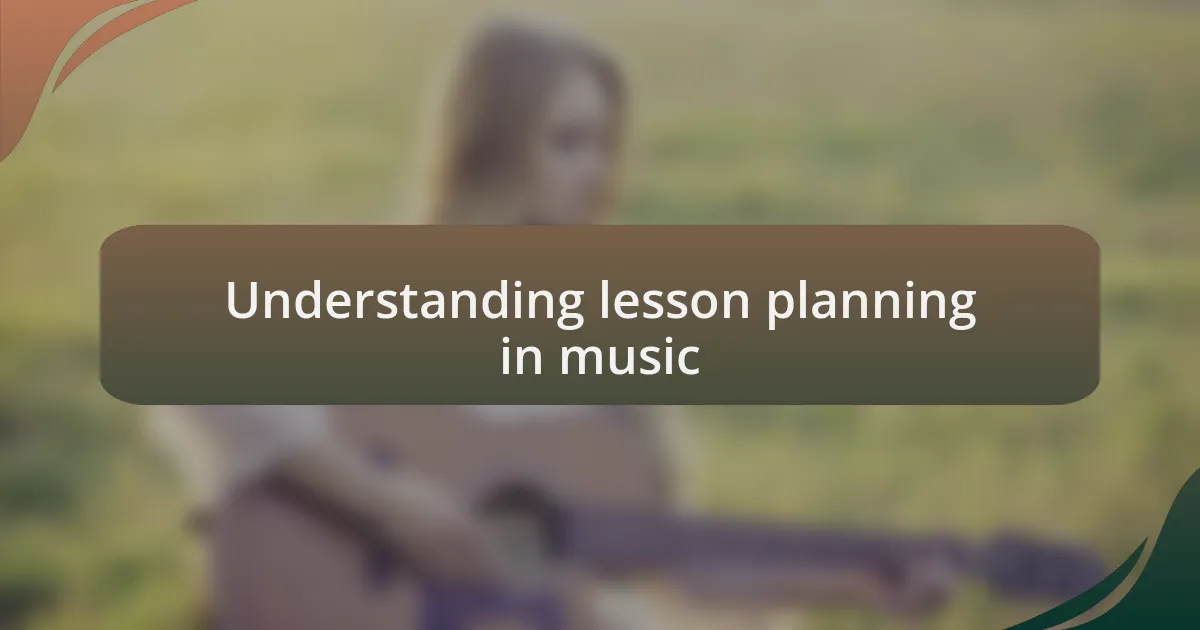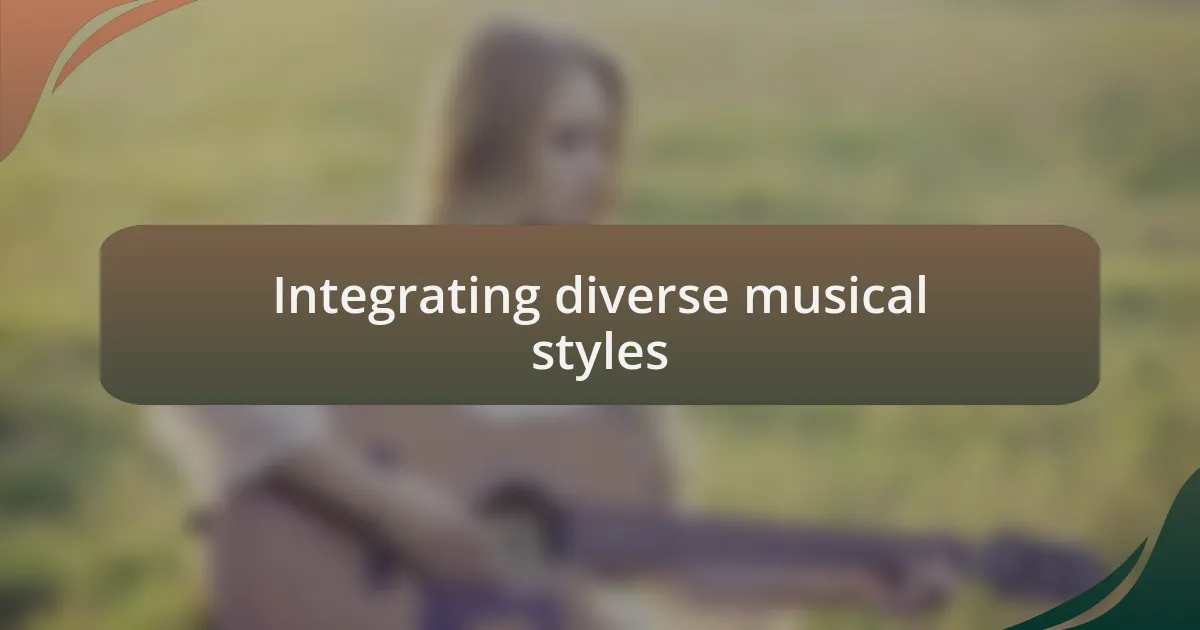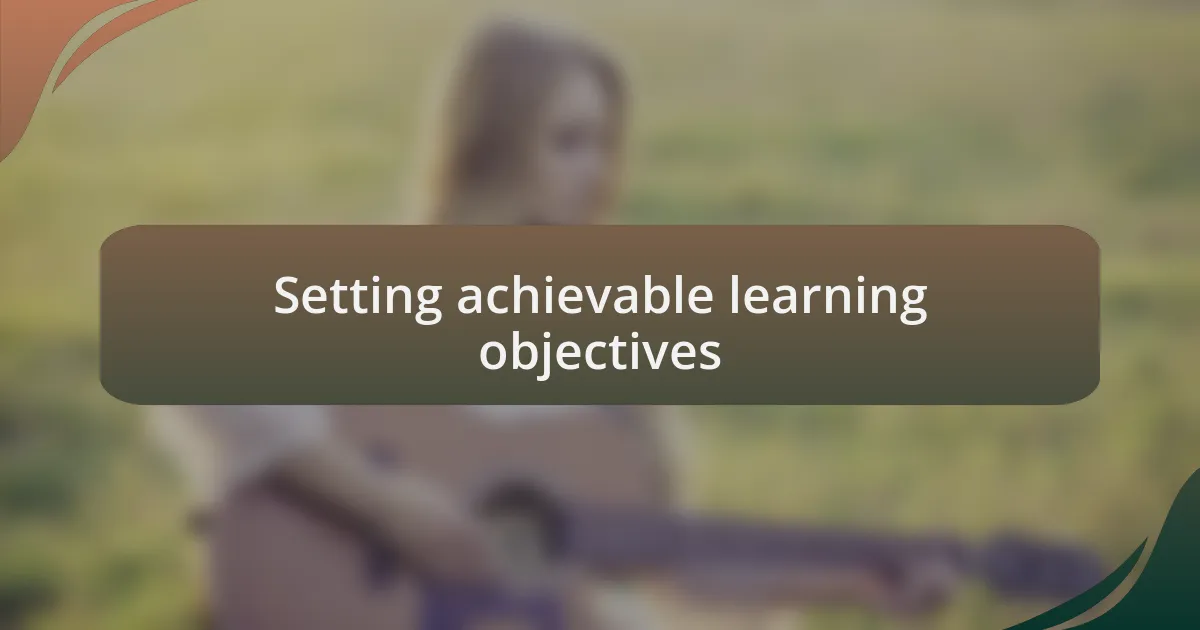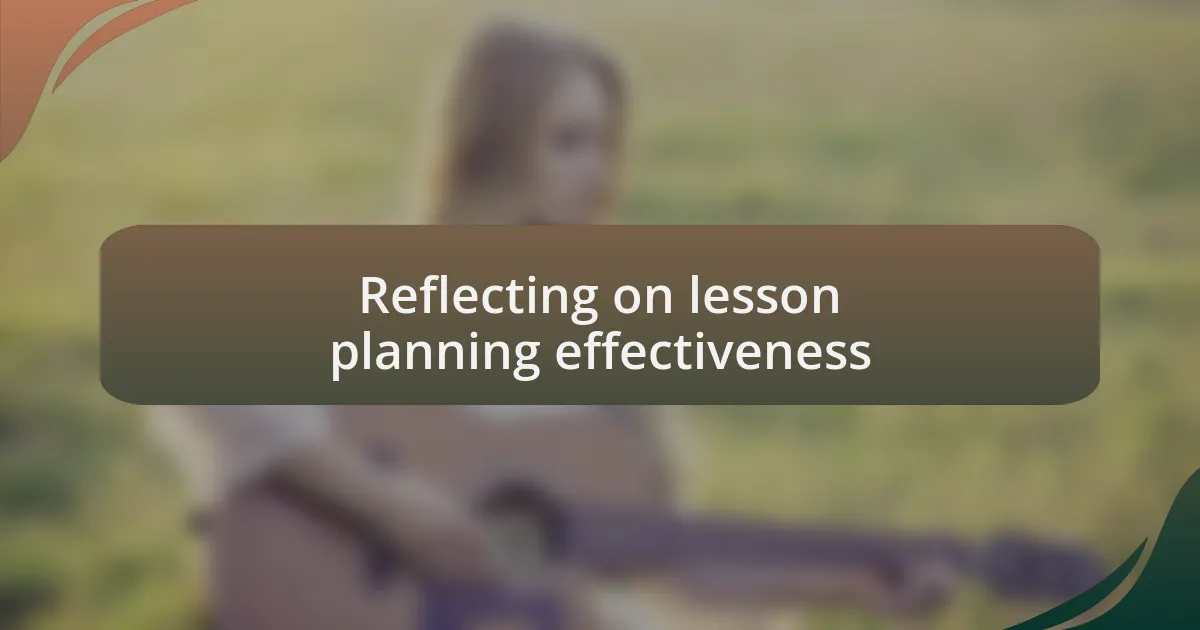Key takeaways:
- Lesson planning in music should prioritize essential concepts while allowing flexibility to inspire creativity and engagement.
- Setting achievable learning objectives helps foster student confidence and motivates them to track their progress.
- Incorporating technology, diverse musical styles, and real-world connections enhances student engagement and enriches their learning experience.
- Reflection on lesson effectiveness and soliciting student feedback are crucial for continuous improvement in teaching methods.

Understanding lesson planning in music
Lesson planning in music is not just about filling time; it’s about creating an experience that resonates. When I started, I often felt overwhelmed by the multitude of things I wanted to cover. How do you decide what is truly essential? Over time, I learned to prioritize key concepts, ensuring that every lesson connects back to broader musical goals.
In my early teaching days, I remember crafting a lesson plan that was so rigid it stifled creativity. I had this great intention of covering every note and rhythm, but the students felt disengaged. That taught me the importance of flexibility in my plans. What good is a lesson if it doesn’t inspire students to explore and express themselves musically? Adapting my lesson plans to balance structure with spontaneity has made a world of difference.
Understanding lesson planning in music also means recognizing the diverse needs of learners. I vividly recall one student who struggled to grasp complex melodies. It was only when I embraced a more hands-on, interactive approach that I saw her flourish. Have you found certain strategies that resonate better with different students? I sure have. Adjusting my plans based on student feedback has helped create a more inclusive and effective learning environment.

Integrating diverse musical styles
Integrating diverse musical styles into lesson plans can be a game changer. I once introduced my students to jazz by playing a recording of Louis Armstrong. Their initial reactions ranged from surprise to curiosity, and it sparked a discussion about improvisation that brought new energy to the classroom. Can you imagine how thrilling it was to watch them experiment with their instruments, letting the rhythms of jazz liberate their creativity?
Incorporating world music alongside Western classical traditions has always been a passion of mine. I vividly remember a lesson where we combined traditional African drumming with contemporary pop music. The students not only learned about different cultures but also began to appreciate the universal language of rhythm. It’s fascinating to see how blending these styles can foster collaboration among students, encouraging them to create something truly unique.
I’ve found that integrating diverse musical styles has also enriched my own understanding of music. Each time my students share their favorite genres, it sparks a dialogue that opens my eyes to new perspectives. Have you ever had a moment where you learned just as much from your students as they did from you? Those moments remind me why I teach and motivate me to continue exploring the vast landscapes of music together with my students.

Setting achievable learning objectives
Setting achievable learning objectives is crucial for fostering student success in music education. I remember a time when I wanted my students to grasp the concept of musical dynamics. Instead of overwhelming them with complex terminology, I simplified the objective to recognizing and demonstrating loud and soft sounds through a simple clapping exercise. By focusing on this specific skill, I noticed their confidence bloom, and it laid a solid foundation for understanding more intricate concepts later on.
Creating clear and realistic goals not only helps students measure their progress but also keeps them motivated. For instance, I once set a goal for my choir class to perform a piece in three weeks. I broke this down into weekly objectives, focusing on mastering a few measures at a time. The look of triumph on their faces when they nailed the final performance was priceless. Have you ever seen a student beam with pride when they accomplish something they once thought was out of reach?
It’s essential to consider each student’s individual learning pace when establishing objectives. In my classroom, some students grasp concepts quickly, while others need more time and reinforcement. I remember a budding guitarist who struggled with chord transitions. By setting mini-goals for mastering one chord per lesson, we celebrated small victories together. These incremental successes not only built his skills but also ignited his passion for playing. I believe that setting achievable objectives creates a supportive environment where every student can thrive.

Techniques for engaging music students
When it comes to engaging music students, I’ve found that incorporating technology can spark their enthusiasm. In my experience, using apps that allow students to compose their own music or manipulate sounds has transformed our lessons. I remember the first time I had my students experiment with a digital audio workstation; their eyes lit up as they explored sounds and rhythms, creating pieces that truly reflected their personalities. Isn’t it fascinating how technology can bridge the gap between learning and creativity?
Another technique that I’ve seen work wonders is fostering a collaborative environment. Group projects not only enhance teamwork but also allow students to express themselves in new ways. For instance, I once organized a small ensemble project where students chose their own pieces to arrange together. Watching them debate between different melodies and harmonies, I realized that music truly becomes a social experience when we let students take charge. Have you ever witnessed the excitement that comes from peer collaboration in a creative setting?
Lastly, I like to incorporate real-world connections into my lessons to keep students engaged. I vividly remember discussing famous musicians’ journeys and their struggles, which transformed our classroom into a space of aspiration and motivation. When students see the relevance of what they’re learning in the context of real-life success stories, it fuels their passion. How can we expect students to engage with music if they don’t see how it resonates beyond the classroom?

Personal strategies that enhance lessons
One strategy that I find particularly effective is tailoring lessons to the diverse musical backgrounds of my students. I often ask them about their favorite songs and artists. For instance, when a student shared their love for K-pop, I used that as a springboard to teach about rhythm and harmony through popular tracks. It was rewarding to see their eyes light up as we deconstructed the very pieces they loved, transforming them from passive listeners to active participants in their learning journey. Have you ever tried tapping into your students’ passions in this way?
Additionally, I believe in the power of storytelling within music education. I often share personal anecdotes about my own musical journey, discussing both my struggles and triumphs. During a recent lesson on improvisation, I recounted a time when I froze on stage during a performance. This vulnerable moment resonated with my students, opening up a discussion about overcoming fear in the creative process. By sharing these personal experiences, I encourage students to find their own voices and embrace their individuality. How can sharing stories reshape the connection between teacher and student?
Finally, incorporating movement into lessons has made a noticeable difference in engagement. I recall organizing a rhythm-based activity where students had to embody the beats through dance. Their laughter filled the room, and as they moved to the music, I witnessed their confidence grow. The energy shifted, and suddenly they were not just learning about rhythm—they were living it. In what ways could adding physicality to your lessons enliven the learning experience?

Reflecting on lesson planning effectiveness
Reflecting on the effectiveness of my lesson planning is a process I deeply value. After each class, I often take a moment to sit down with a cup of tea and jot down what went well and what could have been improved. For instance, after a group lesson on improvisation, I realized that allowing students more time to explore their own ideas led to richer discussions. This reflection not only helps me see the immediate impact of my teaching choices but also informs future lesson designs.
Another part of my reflection involves soliciting feedback from my students. I remember one lesson where I felt the material fell flat, and later, when I asked my students what they thought, one of them mentioned feeling overwhelmed by the pace. This conversation shifted my perspective immensely—sometimes we get so caught up in delivering content that we forget to check in with our learners. How often do you open the floor for honest feedback in your own teaching?
I also find that revisiting my learning objectives during reflection is crucial. Recently, I planned a lesson focusing on the fundamentals of music theory, but when I reflected on its effectiveness, I recognized how students thrived when we connected these concepts to real-world applications. This realization reminded me how important it is to keep aligning lessons with students’ interests and real-life contexts. Have you ever assessed whether you’re hitting the mark with your lesson goals?